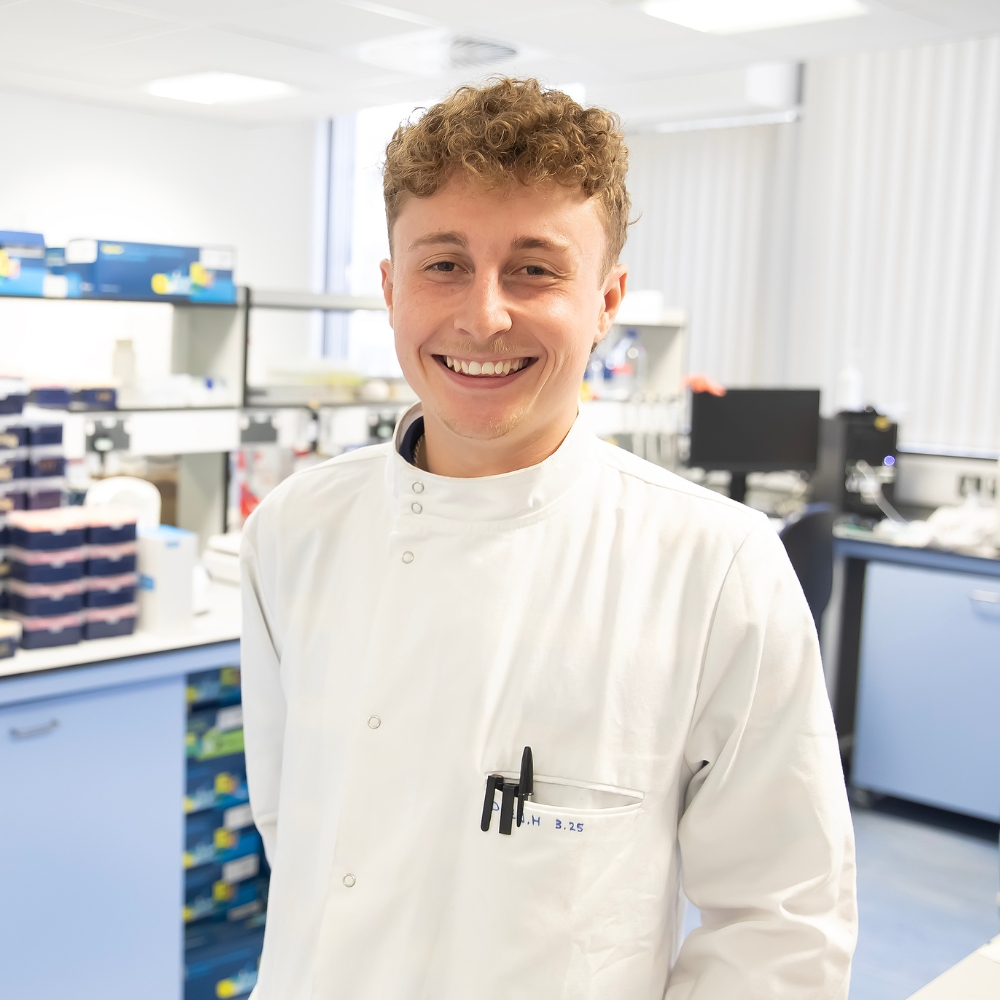Dr Robert Ferguson

-
Email
rmwfer@essex.ac.uk -
Telephone
+44 (0) 1206 872552
-
Location
3SW.3.18, Colchester Campus
Profile
Biography
I investigate the interactions between the environment, microbial communities, and their implications for human and environmental health, with a particular focus on bioaerosols and antimicrobial resistance (AMR). Bioaerosols—airborne microorganisms—play a pivotal role in the Earth system and climate, while also posing significant health risks. These microorganisms can act as sensitisers, triggering respiratory diseases such as asthma, or as vectors for infectious agents like influenza. To better understand bioaerosols and their associated health risks in both indoor and outdoor air, I employ advanced molecular techniques, such as DNA sequencing. In addition to bioaerosols, I study the rising tide of AMR, particularly in the air and water. The quality of aquatic environments, such as rivers and coastal waters, is of growing importance. I collaborate with local stakeholders in Essex to monitor microbial water quality and investigate how chemical pollution affects aquatic ecosystems and the spread of AMR. I am also focused on developing rapid detection methods for environmental pathogens. This includes refining techniques for isolating DNA from the air to detect pathogens and working on methods to detect norovirus in aquatic samples.
Qualifications
-
PhD - Microbial Ecology Cranfield University, (2014)
-
MSc - Sustainable Aquaculture Systems Plymouth University, (2009)
-
BSc(hons) - Marine Biology Plymouth University, (2007)
Appointments
University of Essex
-
Senior Lecturer, School of Life Sciences, University of Essex (1/7/2023 - present)
-
Lecturer, University of Essex (1/6/2020 - present)
-
Senior postdoctoral research officer, University of Essex (1/7/2015 - 31/5/2020)
-
Public Outreach officer: NERC Environmental Microbiology and Human health Program, University of Essex (1/1/2017 - 1/9/2018)
Other academic
-
Postdoctoral Research assistant, University of Aberdeen (1/3/2014 - 30/6/2015)
Research and professional activities
Research interests
Microbial Ecology of Anaerobic Digestion/Wastewater treatment
Microbial Degradation of oil hydrocarbons
Nanoparticles
Bioaerosols
Molecular Microbial Ecology
Environmental microbiology and human health
Molecular Ecology
Antimicrobial resistance (AMR) in the environment
Metagenetics, metagenomics
Environmental Microbiology and Public Health
Air qualtiy (microbial, bioaerosols, machine-learning monitoring tools for monitoring)
Effect of pollution on microbial communities
Detection of pathogens with molecular methods
Water quality
Next generation sequencing and bioinformatics
Current research
Rapid monitoring of bioaerosols in industrial, agricultural and urban environments. RAMBIE
Next-generation sequencing is being used to investigate the airborne microbiome. Metagenetics and transcriptomics are being used to understand how the airborne microbiome interacts with the biotic and abiotic environment. Specific pathogens are being monitored directly in the field with qPCR and LAMP .
A Novel Framework for Predicting Emerging Chemical Stressor Impacts in Complex Ecosystems
Our overarching objective is to develop a new means of assessing how chemical stressors affect freshwater ecosystems and how this will be modulated by climate change.
Teaching and supervision
Current teaching responsibilities
-
Marine Ecology (BS112)
-
Transferable Skills in Life Sciences (BS143)
-
Medical Microbiology (BS235)
-
Molecular Ecology (BS240)
-
Professional skills for Ecological and Marine Scientists (BS257)
-
Marine Resources (BS705)
-
Research Project in Life Sciences (BS832)
-
Gene Technology and Synthetic Biology (BS934)
Publications
Journal articles (17)
Bani, A., Whitby, C., Colbeck, I., Dumbrell, AJ. and Ferguson, RMW., (2024). Rapid In-Field Detection of Airborne Pathogens Using Loop-Mediated Isothermal Amplification (LAMP). Microorganisms. 12 (12), 2578-2578
Ferguson, RMW., Neath, CEE., Nasir, ZA., Garcia-Alcega, S., Tyrrel, S., Coulon, F., Dumbrell, AJ., Colbeck, I. and Whitby, C., (2021). Size fractionation of bioaerosol emissions from green-waste composting. Environment International. 147, 106327-106327
Ferguson, RMW., O'Gorman, EJ., McElroy, DJ., McKew, BA., Coleman, RA., Emmerson, MC. and Dumbrell, AJ., (2021). The Ecological Impacts of Multiple Environmental Stressors on Coastal Biofilm Bacteria.. Global Change Biology. 27 (13), 3166-3178
Saha, M., Ferguson, RMW., Dove, S., Kuenzel, S., Meichßner, R., Neulinger, SC., Petersen, FO. and Weinberger, F., (2020). Salinity and time can alter epibacterial communities of an invasive seaweed. Frontiers in Microbiology. 10, 2870-
Garcia-Alcega, S., Nasir, ZA., Cipullo, S., Ferguson, RMW., Yan, C., Whitby, C., Dumbrell, AJ., Drew, G., Colbeck, I., Tyrrel, S. and Coulon, F., (2020). Fingerprinting ambient air to understand bioaerosol profiles in three different environments in the south east of England.. Science of the Total Environment. 719, 137542-137542
Ferguson, RMW., Garcia-Alcega, S., Coulon, F., Dumbrell, AJ., Whitby, C. and Colbeck, I., (2019). Bioaerosol Biomonitoring: Sampling Optimisation for Molecular Microbial Ecology. Molecular Ecology Resources. 19 (3), 672-690
Ferguson, RMW., Coulon, F. and Villa, R., (2018). Understanding microbial ecology can help improve biogas production in AD. Science of the Total Environment. 642, 754-763
Clark, DR., Ferguson, RMW., Harris, DN., Matthews Nicholass, KJ., Prentice, HJ., Randall, KC., Randell, L., Warren, SL. and Dumbrell, AJ., (2018). Streams of data from drops of water: 21st century molecular microbial ecology. WIREs Water. 5 (4)
Garcia-Alcega, S., Nasir, ZA., Ferguson, RMW., Noël, C., Cravo-Laureau, C., Whitby, C., Dumbrell, AJ., Colbeck, I., Tyrrel, S. and Coulon, F., (2018). Can chemical and molecular biomarkers help discriminate between industrial, rural and urban environments?. Science of the Total Environment. 631–632, 1059-1069
Garcia-Alcega, S., Nasir, Z., Ferguson, RMW., Whitby, C., Dumbrell, AJ., Colbeck, I., Gomes, D., Tyrrel, S. and Coulon, F., (2017). Fingerprinting outdoor air environment using microbial volatile organic compounds (MVOCs) – A review. TrAC - Trends in Analytical Chemistry. 86, 75-83
Dumbrell, ALEXJ., Ferguson, RMW. and Clark, DR., (2017). Microbial Community Analysis by Single-Amplicon High-Throughput Next Generation Sequencing: Data Analysis – From Raw Output to Ecology. Hydrocarbon and Lipid Microbiology Protocols. Microbial Quantitation, Community Profiling and Array Approaches, 155-206
Ferguson, RMW., Gontikaki, E., Anderson, JA. and Witte, U., (2017). The variable influence of dispersant on degradation of oil hydrocarbons in subarctic deep-sea sediments at low temperatures (0-5 °C). Scientific Reports. 7 (1), 2253-
Eduok, S., Ferguson, RMW., Jefferson, B., Villa, R. and Coulon, F., (2017). Aged-engineered nanoparticles effect on sludge anaerobic digestion performance and associated microbial communities.. Science of the Total Environment. 609, 232-241
Ferguson, RMW., Coulon, F. and Villa, R., (2016). Organic loading rate: A promising microbial management tool in anaerobic digestion. Water Research. 100, 348-356
Eduok, S., Hendry, C., Ferguson, RMW., Martin, B., Villa, R., Jefferson, B. and Coulon, F., (2015). Insights into the effect of mixed engineered nanoparticles on activated sludge performance. FEMS Microbiology Ecology. 91 (7), fiv082-fiv082
Ferguson, RMW., Villa, R. and Coulon, F., (2014). Bioengineering options and strategies for the optimization of anaerobic digestion processes. Environmental Technology Reviews. 3 (1), 1-14
Ferguson, RMW., Merrifield, DL., Harper, GM., Rawling, MD., Mustafa, S., Picchietti, S., Balcázar, JL. and Davies, SJ., (2010). The effect of Pediococcus acidilactici on the gut microbiota and immune status of on-growing red tilapia (Oreochromis niloticus). Journal of Applied Microbiology. 109 (3), 851-862
Book chapters (2)
Bani, A., Randall, KC., Clark, DR., Gregson, BH., Henderson, DK., Losty, EC. and Ferguson, RMW., (2022). Mind the gaps: What do we know about how multiple chemical stressors impact freshwater aquatic microbiomes?. In: Functional Microbiomes. Editors: Bohan, DA. and Dumbrell, A., . Elsevier. 331- 377. 978-0-323-98593-2
Whitby, C., Ferguson, RMW., Colbeck, I., Dumbrell, AJ., Nasir, ZA., Marczylo, E., Kinnersley, R., Douglas, P., Drew, G., Bhui, K., Lemon, M., Jackson, S., Tyrrel, S. and Coulon, F., (2022). Compendium of analytical methods for sampling, characterization and quantification of bioaerosols. In: Functional Microbiomes. Editors: Bohan, DA. and Dumbrell, AJ., . Elsevier. 101- 229. 978-0-323-98593-2
Conferences (1)
Vorkamp, K., Viegas, C., Almeida, M., Aretaki, MA., Bossi, R., Castagnoli, E., Cervantes, R., Desmet, J., Diapouli, E., Domínquez, A., Fabian, CM., Fauser, P., Ferguson, RMW., Haverinen-Shaughnessy, U., Hugg, T., Kuurola, P., Lazaridis, M., Massling, A., Paciência, I., Pena, P., Rantala, AK., Schaefer, T., Viana, M., Vornanen-Winqvist, C., Zhu, L. and Salonen, H., (2024). The InChildHealth Walkthrough Survey - towards a standardized characterization of classrooms for Indoor Air Quality studies in Europe
Grants and funding
2025
Closing the budget in marine atmospheric Oxidative Capacity through the quantification of Oceanic VOC emissions (COCO-VOC)
Natural Environment Research Council
2024
Molecular methods for characterization of antimicrobial resistant bioaerosols
The Aerosol Society
2022
Airborne antimicrobial resistance: identifying the main environmental sources and health impacts
Academy of Medical Sciences
Identifying Determinants For Indoor Air Quality And Their Health Impact In Environments For Children: Measures To Improve Indoor Air Quality And Reduce Disease Burdens
European Commission
School and community engagement with tiny forests to enhance environmental and human health
North East Essex Clinical Commissioning Group
2021
Exploring how sources, behaviour and mitigation strategies influence Indoor Air Quality: A Pilot Study
University of York (Funder)
Determine the drivers of pathogen and AMR occurrence in SSA water-harvesting systems to inform the design of interventions strategies
NERC Environmental Omics Facility (Funder)
2020
The effect of compost bioaerosols on microbial soil ecosystem services in surrounding farmland
Applied Microbiology International (formerly SFAM)
NI: BioSkyNet: the first global network of bioaerosols researchers
Natural Environment Research Council
2017
Using metagenomics for fine-scale resolution of pathogen functional and phylogenetic diversity in farm bioaerosols
The Aerosol Society
2016
Characterisation of bioaerosol bacterial communities in different size factions from urban, industrial and agricultural environments
The Aerosol Society

